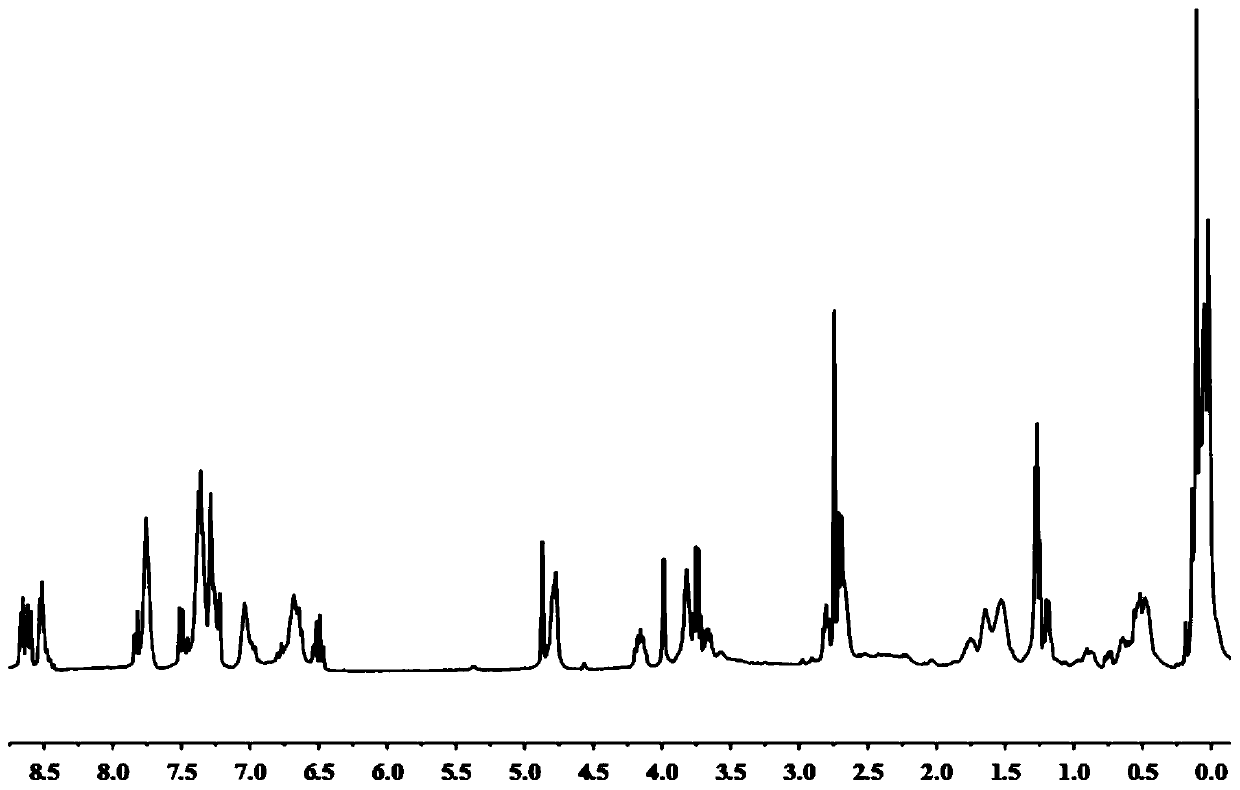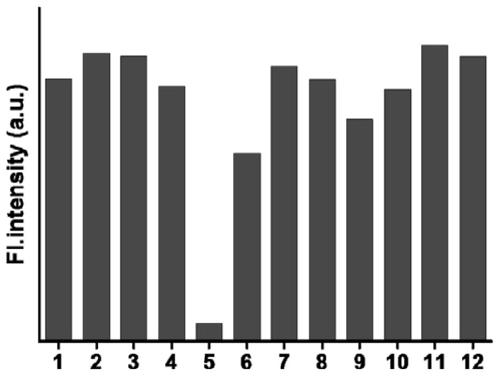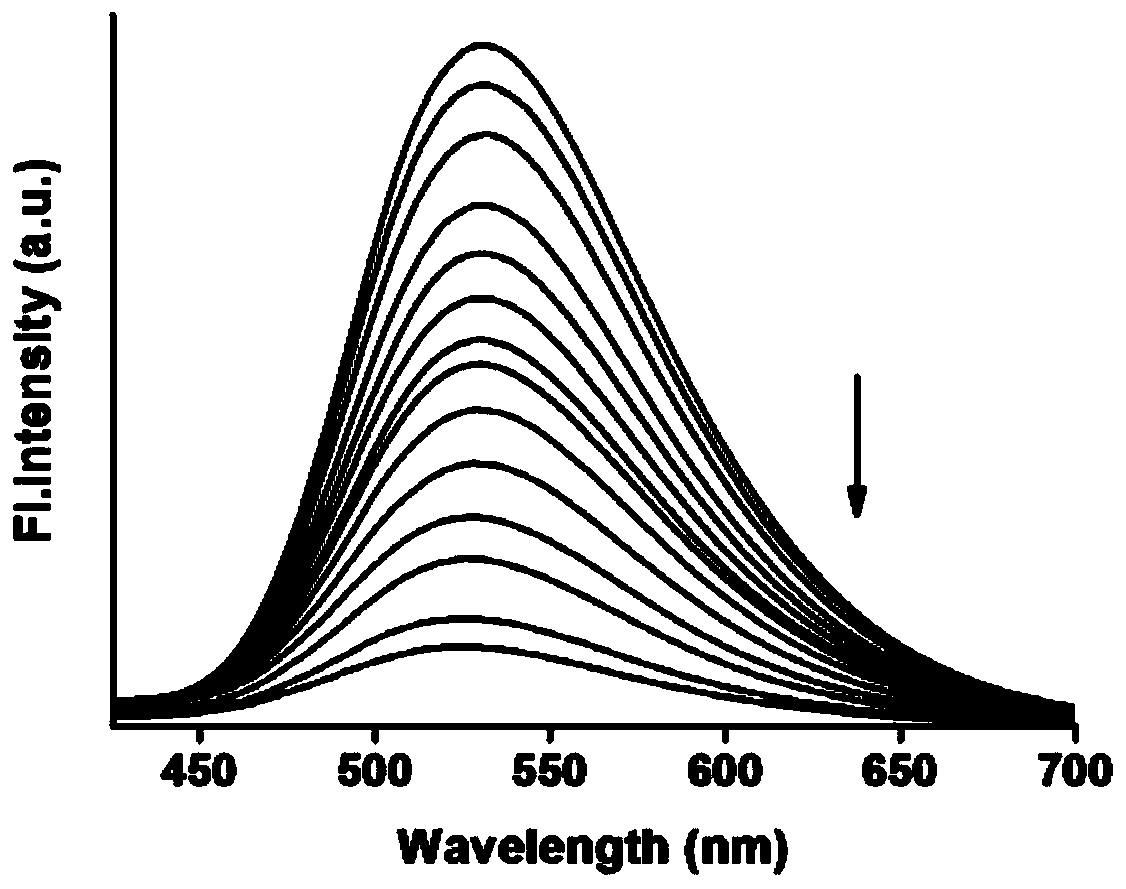Organosilicon polymer fluorescent probe for detecting thiocyanate ion, and synthesis and application thereof
A fluorescent probe and thiocyanate technology, applied in the direction of fluorescence/phosphorescence, luminescent materials, material excitation analysis, etc., can solve the problems that affect the application of the probe, the effect has a large impact, and the probe has high biological toxicity
- Summary
- Abstract
- Description
- Claims
- Application Information
AI Technical Summary
Problems solved by technology
Method used
Image
Examples
Embodiment 1
[0041] Example 1 Synthesis of Compound Probe V1
[0042] (1) Synthesis of Compound A
[0043]
[0044] Dissolve 2.3 g of bisphenol fluorene in 20 mL of ethanol, and then dissolve 0.75 g of paraformaldehyde in 20 mL of toluene. In a 250 mL eggplant flask, add MM NH2 2 g, dissolved in 100 mL of ethanol, then added the prepared formaldehyde solution and bisphenol fluorene solution, heated at 110°C and stirred for reflux for 24 h. Rotary evaporation, drying to obtain compound A.
[0045] (2) Synthesis of Compound B
[0046]
[0047] Dissolve 2.77 g of 4-bromo-1,8-naphthalene anhydride in 50 mL of ethanol, then dissolve 3 g of sodium methyl mercaptide in 50 mL of ethanol, and add them together into a 250 mL eggplant-shaped reaction flask, and stir at room temperature for 24 h. After the reaction, 100 mL of water was added to the reaction flask to obtain a yellow precipitate, which was filtered and dried to obtain a yellow solid, which was purified by column chromatograp...
Embodiment 2
[0051] Example 2 The selectivity of compound V1 fluorescent probe to different anions
[0052] Prepare 5 mL of PBS aqueous solution (pH = 7.4) and the fluorescent probe V1 mother solution obtained in Example 1 at a concentration of 1 mM as a spare.
[0053]Add 10 μL probe stock solution, 225 μL DMSO and 10 equivalents of sodium chloride, sodium acetate, sodium sulfide, sodium bicarbonate, sodium thiocyanate, sodium hypochlorite, sodium nitrite, sodium nitrate, sodium phosphate, sodium sulfate, carbonic acid Sodium solution, dilute to 3 mL with phosphate buffer solution PBS, shake well, after 30 min, perform fluorescence detection (λ ex =405 nm, λ em =530 nm), to establish a histogram of fluorescence intensity after adding each ion solution, such as figure 2 shown. Depend on figure 2 It can be found that other ions have little effect on the fluorescence of compound V1, while the addition of thiocyanate significantly weakens the fluorescence of compound V1.
Embodiment 3
[0054] Example 3 Fluorescence titration detection of different concentrations of thiocyanate on probe V1
[0055] Prepare 10 mL of an aqueous solution with a concentration of 10 mM thiocyanate and a mother solution of the fluorescent probe V1 obtained in Example 1 with a concentration of 1 mM as spares.
[0056] Prepare the probe at a concentration of 10 μM, interact with different concentrations of thiocyanate (5, 10, 15, 20, 25, 30, 35, 40, 50, 60, 70, 80, 90, 100 μM), and conduct Fluorescence detection (λ ex = 405 nm, λ em = 530 nm), calculate the fluorescence intensity in each system, and establish the standard curve of fluorescence intensity and thiocyanate concentration. like image 3 As shown, as the concentration of thiocyanate increases, the fluorescence intensity of the reaction system decreases gradually, and when the concentration of thiocyanate reaches 100 μM, the fluorescence intensity of the reaction system reaches the lowest state.
PUM
 Login to View More
Login to View More Abstract
Description
Claims
Application Information
 Login to View More
Login to View More - R&D
- Intellectual Property
- Life Sciences
- Materials
- Tech Scout
- Unparalleled Data Quality
- Higher Quality Content
- 60% Fewer Hallucinations
Browse by: Latest US Patents, China's latest patents, Technical Efficacy Thesaurus, Application Domain, Technology Topic, Popular Technical Reports.
© 2025 PatSnap. All rights reserved.Legal|Privacy policy|Modern Slavery Act Transparency Statement|Sitemap|About US| Contact US: help@patsnap.com



